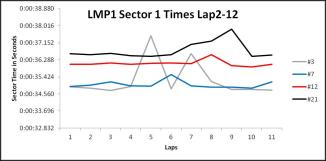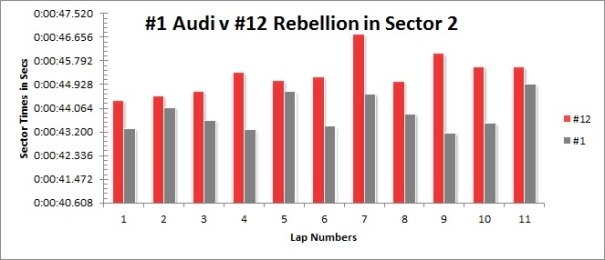Following part one of my small series, reviewing the data from the World Endurance Championship 2014, I left a few things to be analysed. Firstly, I’m going to take a closer look at 2014 Le Mans 24hrs and how Audi #2 managed to win the race even though they were in the pits for 58min 12sec!
The first place I will look is at their race pace, compared to there competitors.
I’m going to ignore most of the data you will see in the above table, we shall concentrate on the times in the Le Mans column for now. The table shows average lap times from all the races in the 2014 WEC, I used 140 laps from each car to work out the average lap time, I removed all pit stops and slow laps to try to give the most accurate race pace time. I have also highlighted the fastest car from each round in green.
From the data that is presented in front of us Audi won the Le Mans 24hrs not only because of luck, but a combination of quite a few factors. Probably , and most importantly the car was the quickest in race trim 1.1 seconds quicker than #8 Toyota and 2.1 sec quicker than the #20 Porsche. If you think back to the race, #8, #20, #7, #14 and #1 all experience problems as did the #2 car itself. Audi managed to keep there servicing times to a minimum even though they needed to change a turbo, while there competitors suffered with “bigger problems”. It turns out Audi took just 17mins to change the turbo, please remember that’s a smoking hot engine and turbo that needed to be removed and replaced! I will also credit the designers at Ingolstadt, for making the turbo accessible. When the #2 got back into the race it managed to remain at a quicker pace, keeping all other competitors behind them. Although the Pit Stop table in part 1 doesn’t show it #8 Toyota didn’t lose most of its time in the pits, it actually lost most of it recovering from the early accident a 14min 40sec lap didn’t help. I must also add that the #7 Toyota was leading by some way, when it suffered an electric fault putting it out of the race.
Further notes from our average lap time data was just how dominate the #8 Toyota was throughout the season, having the fastest race pace on, quickest in 6 of the 8 races. Porsche #14 was quickest at the final round at Interlagos where it secured Porsche’s first win, since the return of the German manufacturer giant.
Now it’s time to take a look at my imaginary monster WEC circuit, it consists of one lap of each circuit added together. Total distance for a single lap would be 52.67km (32.1mi). The times I have recoreded are, an ideal lap time, this is based on the quickest race lap (think of these as sector times) of each car added together to give us an ideal time. Then using the average race data, I have created an average race pace lap time too. I have also calculated the difference between ideal and average to show the seconds lost when driving at race pace.

Lets start by taking it look at the results, no prizes for guessing who was the quickest, Anthony Davison and Sebastian Buemi dominated all season, ideal lap time 3.5 seconds quicker than anyone else and average time 4 seconds quicker! In second place comes the sister car #7 from Toyota Hybrid Racing. The rest of the pack becomes a little more complicated, where the #1 is quicker than the #2 over a race distance the #2 was faster in a single lap. #14 Porsche was on pace with #1 over a single lap but a full second down over a race distance. The car that disappointed the most was the overall pace of the #20 with Mark Webber, most of us are F1 fans before we become fans of any other racing series, we all wanted Mark to excel. Unfortunately this never really got going with a slower/unreliable car at the start of the season, an average middle with a podium or two, then a bad ending with the huge accident suffered on the start/finish line at Brazil. I want to add it wasn’t all of Mark’s doing, sportscar drivers are a team, and as a team, they will need to improve to make progress in 2015.
I want to quickly mention the #1 Audi, not only did it turn out to be the final year for Tom Kristensen before he retires, but he, and his team mates managed to keep the gap between ideal lap time and average the closest throughout the season, only losing an average of 3.5sec per round.
Finally I want to leave you all with this final stat, Tom Kristensen, 9 time Le Mans Winner. Thank you TK.







